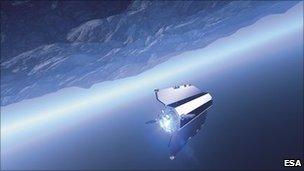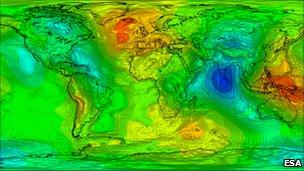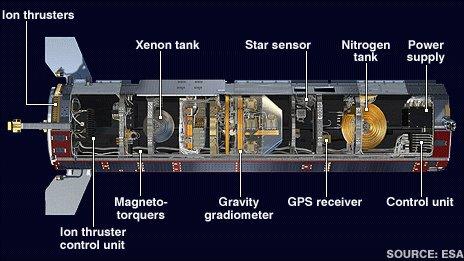Goce gravity satellite 'caught the cold'
- Published

Goce flies lower than any other scientific satellite
The flagship European Earth observation satellite Goce was knocked offline because some of its onboard systems got too cold as it circled the planet.
The spacecraft is on a mission to make the most precise maps yet of how gravity varies across the world.
But when a fault appeared in its one fully functional computer, the flow of science data to the ground stopped.
Controllers managed to recover the situation only when they turned the heat up inside the satellite.
"We're really thrilled we've got Goce back," mission manager Dr Rune Floberghagen told BBC News, "but we also need to find out what went wrong. I don't think there's anyone who has a full understanding of what happened."
Goce's chilly state came to light when a patch was sent up to the hamstrung spacecraft to enable it to send key engineering data to the ground.
This revealed the floor in a part of the satellite holding the battery, the computer and the onboard power distribution unit was just a few degrees above zero.
And when the command was then despatched to Goce to tell it warm itself by about seven Celsius, the normal flow of telemetry was suddenly re-established.

Goce has acquired some two-thirds of the gravity data originally expected from the mission
Dr Floberghagen explained: "The anomaly happened on 8 July which is very close to when the satellite is at its furthest from the Sun. Plus, in the case of Goce, we are flying through the eclipse of the Earth for a good portion of each orbital revolution; so it's at that time of the year when the satellite experiences the coldest temperatures."
However, the chill was not particularly extreme and engineers are continuing to investigate why the electronics were impacted in they way they were. Efforts continue also to try to get some functionality back into Goce's primary, or A side, computer, which was hit by a chip failure in February. Goce has been forced to work off its redundant, or B unit, ever since.
The restoration of Goce's capabilities could not have come at a better time.
The mission team is due to go before European Space Agency member-state delegations this week to ask for the funds to extend a project that had up until the anomaly returned some remarkable science.
From an altitude of just under 260km, Goce senses tiny differences from place to place in the tug of Earth's mass.
Scientists will use its data to make high-resolution maps of the geoid which, simply put, traces "the level" on our planet.
Geoid information has many applications but perhaps the biggest knowledge gains from Goce will come in the study of ocean behaviour.
By combining gravity data with measurements of sea-surface height gathered by other spacecraft, scientists will be able to track the direction and speed of ocean currents.
Understanding better how the seas move heat around the planet will help improve the computer models that are used to forecast global climate change.
The pan-European team working on Goce hopes to win approval for a mission extension up until at least the end of 2012.

- Published21 August 2010